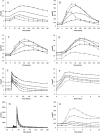The pathophysiology of glucose intolerance in newly diagnosed, untreated T2DM
- PMID: 34561756
- PMCID: PMC8841334
- DOI: 10.1007/s00592-021-01785-9
The pathophysiology of glucose intolerance in newly diagnosed, untreated T2DM
Abstract
Aims: The two predominant pathophysiological defects resulting in glucose intolerance are beta-cell dysfunction and insulin insensitivity. This study aimed to re-examine beta-cell function and insulin sensitivity across a continuum from normal glucose tolerance (NGT) to early type 2 diabetes (T2DM) employing highly specific insulin, C-peptide and intact proinsulin assays.
Materials and methods: A total of 104 persons with NGT, 85 with impaired glucose tolerance (IGT) and 554 with newly diagnosed T2DM were investigated. Following an overnight fast, all underwent a 4-h standardised mixed meal tolerance test (MTT), and on a second day, a sub-group underwent a frequently sampled insulin-modified intravenous glucose tolerance test (FSIVGTT) over a 3-h period. The participants were stratified according to fasting glucose and BMI for analysis.
Results: The MTT revealed that increasing FPG was accompanied by progressively elevated and delayed postprandial glucose peaks. In parallel, following an initial compensatory increase in fasting and postprandial insulin responses there followed a progressive demise in overall beta-cell secretory capacity. FSIVGTT demonstrated a major reduction in the early insulin response to IV glucose in persons with IGT accompanied by a dramatic fall in insulin sensitivity. Beyond pre-diabetes, ever-increasing fasting and postprandial hyperglycaemia resulted predominantly from a progressively decreasing beta-cell secretory function.
Conclusion: This study utilising improved assay technology re-affirms that beta-cell dysfunction is evident throughout the spectrum of glucose intolerance, whereas the predominant fall in insulin sensitivity occurs early in its evolution.
Keywords: Beta-cell function; Glucose intolerance; Insulin sensitivity; Type 2 diabetes mellitus.
© 2021. The Author(s).
Conflict of interest statement
GJD, SDL, RP and DRO have no conflicts of interest to declare.
Figures



References
-
- Tabak AG, Jokela M, Akbaraly TN, Brunner EJ, Kivimaki M, Witte DR. Trajectories of glycaemia, insulin sensitivity, and insulin secretion before diagnosis of type 2 diabetes: an analysis from the Whitehall II study. Lancet. 2009;373(9682):2215–2221. doi: 10.1016/S0140-6736(09)60619-X. - DOI - PMC - PubMed
MeSH terms
Substances
LinkOut - more resources
Full Text Sources
Medical

